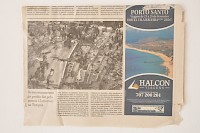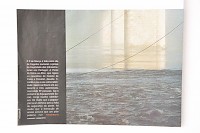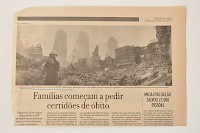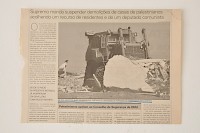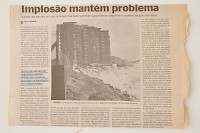Documentation is shifting the focus from the reality and its experience to the processes through which reality is interpreted, valorized, to how information is codified, in other terms archived. Becoming part of the object itself, these practices regenerate the documented object in Carlos Bunga's work. What is the nature of a document that chronicle histories from which we have no more evidence?... Bunga's drawings or collection of newspapers could seem a documentary practice par excellence: re-archiving an already archived event, one that has hitherto been transformed into information. But contrary to an usual archival material, his intervention reinvests the original event with its theatrical dimension: an expanded object results from his writings, drawings and re-situating of this material into a personal register of meaning, that renegotiates, oscillates. This new record, unstable, in its not clearly defined borders, marks a cumulative shift: at once part of a medial archive (a newspaper for example) and part of a personal archive of meaning, it is enriched with incoherences, multiplicity and the incomprehensible – as the original event itself.
As Bunga himself repeatedly affirms he rather works with potentialities that situations carry, than with the situations themselves. He therefor operates actually with what Jacques Derrida calls with a grammatical term, “the future anterior”: “The archive as not being simply a recording of the past, but also something that is shaped by a certain power, a selective power, and shaped by the future, by the future anterior”. At another point Jacques Derrida discusses the future anterior as a “double desire for the past and the future.”1
Bunga's personal archive with newspaper clippings of architectural disasters describes deviant parcourses that a construction can take. The snapshots and headlines reveal inert, fossilised buildings that seems momentarily stroke by a cinematic movement. Unexpected happenings bring out an intrinsic dynamics of architecture which becomes apparent when architecture ceases to fulfil its habitational functions. These natural, logistic or constructional “accidents” – momentary come-backs to the chaos that precedes any built form – take to surface a force of space that remains uncontrolled by the human, unpredictable and ambiguous. Degradation discloses, with its social and political origins, rotten infrastructures that Bunga implicitly amends in relation to the Portuguese reality. It creates also a micro-climate in which Bunga studies – as in a laboratory – the laws which dominate decomposition of form. His mere joining together of files – medially transmitted information and images – reveal how building is based on devouring of matter and resources, how consume can dissolve or annul representation and how a dominant social and political order has lost the means of critical self-analysis. A precarious and feeble social body dismantles until it collapses into raw material. Some of the titles review: ”87 Dead in 6 Months, Fallen From Scaffolds”, “Building Threatens Passers-by”, “Ruin Imminence”, “ 2 Years old Building falls apart in Vila Nova de Gaia”, “Collapse in the Centre of Madrid”, “Implosion Maintains the Problem”, “The Oklahoma City Bombing 1995”, “Demolition of Palestinian Houses”, “Portugal: An Old Country in the eyes of the Germans”, “Saviour in the Dantesque Scenario of the Ruins of World Trade Centre”. Images from these events show architectures like remnants that society could not maintain or leave behind, ruins that consume at their turn the individual.
“The processual state of objects tends to be a place in constant transformation and subjected to questionings, there is no finalized form in the structure of these objects. Any finalized form induces a meaning of death and, as a consequence, the process of its restoration comes out as a necessity of perpetuating the form through its memory of time.”2
These alterations and fracturing of the spatial and social continuum that a construction affirms simply by standing there and the denial of “architectural models” that come with this, are equally pursued by Bunga not only in his newspaper documents, but also in his drawing series, where documentation becomes the means to release an un-hierarchical space, which is performative.
Working with documents is considered by Bunga as being the basis of his work. Transgressing the physical limitations that exhibition spaces as containers of his work trace, he is expanding these limits into a personal laboratory and altering by his interventions the initial conditions. His new tools that transform his vision into a document of what reality could have been in certain circumstances, are meant, to give “the possibility of a multifaceted thinking about a universe, which is constituted by objects that can have more open and ambiguous meanings. The variation of ideas and forms (...) are meant to allow a great flexibility in the manner of understanding the world."3
In his 2007 series of works like “Temporal Dimension”, “Conscience”, Precarious Environments”, Begins”, this return to the fluidity of the original event is transmitted by his choosing of images where people are both part of and watching the photographed events, scrutinizing (like us – the viewer of the works) the scenes in front of them. Bunga marks the silhouettes on these photos as mute and contemplative presences that for him signify “conscience”. This “meditatious” mirroring of a reality that cannot be fixed, ordered, surpassed by attributing it into the drawer of a (medial) archive, remains mysterious but most of all – it is relational. His documentations keep the temporal and dramatic qualities of the present to which we relate and the event is a constitutive part of it: imminence, fragility, instability, “reality” are its qualities – as Bunga annotates on his drawing “Conscience”.
More than with particular documents or particular events, Bunga works with the ways in which reality can be re-assembled in a way that shifts the moment present on the time scale: in his 2009 drawings series “Ruins Projects”, the “Ruin” (a work which has been materially realized 2008 at Art Unlimited/Art Basel) serves as a fundament for a ulterior construction, as it also represents the visible remain of a presumably posterior construction, that Bunga archaeologically releases from the subterranean. The ruin, as map, as grave, as labyrinth, as groundwork or foundation of a building, as roof, as cemetery or citadel, as suspended terrace, is at the same time a quintessence of various stylistic elements, of different geographical and cultural appurtenances and carries immemorial vestiges. Flat and inexpressive, self-contained in some drawings, it is the support for architectural flamboyance, in others. Bunga works rather with a paradigm of architecture, than with architectural prototypes or concrete exemplars and extracts, through the means of documentation, the dynamic, creative and transformative power that lies in architecture – as a quintessence of processes of construction and deconstruction. This dimension of building on which Bunga draws, recalls one of the Aphorisms of Jaques Derrida which discusses the term performative in relation to the deconstructivist architecture.
„[…] We understand by this [n.b. performativity] the moments in which the knowledge becomes work, when the theoretical questioning cannot be separated any more from the event that is called 'creation', 'composition', 'construction'. It suffices not to say that architecture is one of the best paradigm for that. Alone the word and the concept paradigm have an exemplar architectural value. (Aphorisms 34)“4
In the “Nomada” series, 2008, android beings carry head-architectures. These hybrid, walking buildings collage an amphibian body with a robotic, chip-like brain structure of architectural sketches or plans. The Nomad beings “document” by evoking architectural paradigms, but at the same time they situate architecture. They carry on their heads and re-locate the memory of lost spatial configuration. The figures could be seen as hypostases of an ancestral digging after models of coalescence between man and space. Rather than the heideggarian dwelling (where the human being lives in and is contained by architecture), these figures speak about memory and the possibility of architecture being performed by the human. The Nomads show how the human can store/archive architecture by being it while layers of information are condensed and compressed into a new entity – the mobile architecture – that carries all its data with itself. In these drawings there is also a shift of focus point from the objecthood of architecture to its environmental qualities.
The fact that mutations of the space can release a latent political subtext is explained in relation to the archive by Jacques Derrida in his text Archive Fever. A Freudian Impression5, which represents the transcription of a conference delivered by Derrida in June 1994 in London. The ambiguity of the borders of the archive, the questioning of where does the outside of the archive begin, is what Derrida designates as the fundamental question of the archive. The theory of the archive is conceived by him through its assimilation to the processes of memory-formation in psychoanalysis. The mix of reality, unreality, the public, the private and virtual is deeply connected not only to memory storage, but also to memory retrieval. The political power of the archive which derives from here, is staged by the archive itself, which re-flects the processes of its own controlling.
Derrida reminds that the Greek and Latin terms for archive designated a place where legal documents where kept, a place where things commence and from where authority emanates. Therefor there are more dimensions of the archive: the sequential (temporal), the material and the juridical (political). For Derrida the fundamental force of the archive is that of preserving both the historical and psychic substance of humanity – through technology and through tradition. Since the theory of psychoanalysis is for Derrida the theory of the archive, for him also the question of the death is a fundamental one. “The death drive is anarchivic” says Derrida6 and he also writes that "what is no longer archived in the same way is no longer lived in the same way.”7. According to him, an archive cannot exist without an external place to itself, which is indissociable from the death drive, so from destruction.
In his work Bunga addresses the fact that the process of archiving is altering the nature of reality, while insisting on the deep connection between archiving and destruction and how annihilation of memory determines the drive to archive. In the 2007-2008 video “More Spaces for other constructions” he rubs out documents-drawings of well known constructions – ones that already belong to a common “Archive”. Destruction in Bunga's work is deeply anarchic not only by deleting an archival order and opening it for new criteria, but also by showing that for democratization access and direct participation to the archive, to its constitution and its interpretation, are essential.
Derrida relates participation with time in Archive Fever, while explaining that the technological power of the archive determines the nature of what is archived and as the content and the meaning of the archive is reshaped by all the people that participate in it, the archive is dependent on what is coming - “on what will have come”8. Its openness towards what might come into the future determines also the impossibility of the archive to be saturated or closed. This future-oriented dimension of the archive, is that which creates, as Derrida stresses, its possibility to be always reinterpreted, but also our political and ethical responsibility towards it. Bunga works precisely with this dimension of the archiving, that it is not simply recording the past, but also forming it. The past is actually shaped by the future, which retrospectively or retroactively endows it with meaning.
Bunga's works seems in general to be saturated with art-historical references, but at the same time deconspire what they are quoting. In his 2009 “Ruins Projects” or in the “Mutations” series, the monuments are half decayed, fictive, bricollaged, non-monumental and finally defy already existent historical narratives. Anti-hegemonical since they do not belong to or symbolically mark a certain territory, they also affirm another conception of the monument. It has been extensively written on the relation between the monument and the document and in Bunga's architecturally oriented work, this connection comes constantly to the surface. Derrida mentions in Archive Fever that the monument is deeply related to amnesia and hypomnema – the fading of memory9. At the same time: ”The archivization produces as much as it records the event.”10 The monument is therefor built from destruction and forgetfulness and, as an archive, it works against itself. In this sense Bunga's monuments are at the same time political experiences, as they are a-historical. They refer an unrepresentable reality, that is not experienceable in real time. Paul Ricoeur shows11 that the common meaning attributed to documents in the present, has overpassed its original meaning of 'having the function to teach' and occupied the function of being an evidence, constituting a proof. Any trace left by history can be therefor interpreted as a document and Ricoeur talks about these traces as “involuntary testimonies”. Citing Jacques Le Goff, Ricoeur reminds that archives have been until the middle of the 19th century been called “monument”. These architectural constructions are nevertheless different from the documents (understood in the above sense as traces) since a monument has been built with a predetermined finality – to commemorate. At this junction point could be seen Bunga's composite monuments, with fragments from various temporal spans: as traces that involuntary commemorate. As they do not work with symbolic content, serving to no particular discourse, they have the chance of preserving a critical statement12.
Bunga's pensive works transmit a spirit that Paul Ricoeur differentiates as follows: “Historians look for the trace of the past as it actually occurred. The problem of what the trace as such signifies is not the historian's, but the philosopher's”.
Marta Jecu
